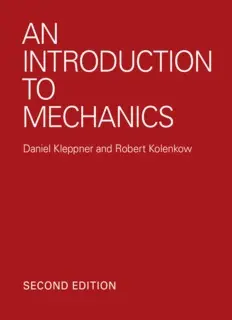Table Of ContentAnIntroductiontoMechanics
For40years,KleppnerandKolenkow’sclassictexthasintroducedstu-
dents to the principles of mechanics. Now brought up-to-date, this re-
vised and improved Second Edition is ideal for classical mechanics
coursesforfirst-andsecond-yearundergraduateswithfoundationskills
inmathematics.
Thebookretainsallthefeaturesofthefirstedition,includingnumer-
ousworkedexamples,challengingproblems,andextensiveillustrations,
andhasbeenrestructuredtoimprovetheflowofideas.Itnowfeatures
• Newexamplestakenfromrecentdevelopments,suchaslaserslowing
ofatoms,exoplanets,andblackholes
• A “Hints, Clues, and Answers” section for the end-of-chapter prob-
lemstosupportstudentlearning
• Asolutionsmanualforinstructorsatwww.cambridge.org/kandk
daniel kleppner is Lester Wolfe Professor of Physics, Emeritus, at
MassachusettsInstituteofTechnology.Forhiscontributionstoteaching
he has been awarded the Oersted Medal by the American Association
of Physics Teachers and the Lilienfeld Prize of the American Physical
Society.HehasalsoreceivedtheWolfPrizeinPhysicsandtheNational
MedalofScience.
robert kolenkow was Associate Professor of Physics at Mas-
sachusettsInstituteofTechnology.Renownedforhisskillsasateacher,
KolenkowwasawardedtheEverettMooreBakerAwardforOutstanding
Teaching.
AN
Daniel Kleppner
Robert Kolenkow
INTRODUCTION
TO
MECHANICS
SECOND EDITION
UniversityPrintingHouse,CambridgeCB28BS,UnitedKingdom
CambridgeUniversityPressisapartoftheUniversityofCambridge.
ItfurtherstheUniversity’smissionbydisseminatingknowledgeinthepursuitof
education,learningandresearchatthehighestinternationallevelsofexcellence.
www.cambridge.org
Informationonthistitle:www.cambridge.org/9780521198110
(cid:2)c D.KleppnerandR.Kolenkow2014
ThiseditionisnotforsaleinIndia.
Thispublicationisincopyright.Subjecttostatutoryexception
andtotheprovisionsofrelevantcollectivelicensingagreements,
noreproductionofanypartmaytakeplacewithoutthewritten
permissionofCambridgeUniversityPress.
FirsteditionpreviouslypublishedbyMcGraw-HillEducation1973
FirstpublishedbyCambridgeUniversityPress2010
Reprinted2012
SecondeditionpublishedbyCambridgeUniversityPress2014
PrintedintheUnitedStatesbySheridanInc.
AcataloguerecordforthispublicationisavailablefromtheBritishLibrary
ISBN978-0-521-19811-0Hardback
Additionalresourcesforthispublicationatwww.cambridge.org/kandk
CambridgeUniversityPresshasnoresponsibilityforthepersistenceoraccuracyof
URLsforexternalorthird-partyinternetwebsitesreferredtointhispublication,
anddoesnotguaranteethatanycontentonsuchwebsitesis,orwillremain,
accurateorappropriate.
CONTENTS
PREFACE pagexi
TOTHETEACHER xv
LISTOFEXAMPLES xvii
1 VECTORSANDKINEMATICS 1
1.1 Introduction 2
1.2 Vectors 2
1.3 TheAlgebraofVectors 3
1.4 MultiplyingVectors 4
1.5 ComponentsofaVector 8
1.6 BaseVectors 11
1.7 ThePositionVectorrandDisplacement 12
1.8 VelocityandAcceleration 14
1.9 FormalSolutionofKinematicalEquations 19
1.10 MoreabouttheTimeDerivativeofaVector 22
1.11 MotioninPlanePolarCoordinates 26
Note1.1 ApproximationMethods 36
Note1.2 TheTaylorSeries 37
Note1.3 SeriesExpansionsofSomeCommon
Functions 38
Note1.4 Differentials 39
Note1.5 SignificantFiguresandExperimental
Uncertainty 40
Problems 41
vi CONTENTS
2 NEWTON’SLAWS 47
2.1 Introduction 48
2.2 NewtonianMechanicsandModernPhysics 48
2.3 Newton’sLaws 49
2.4 Newton’sFirstLawandInertialSystems 51
2.5 Newton’sSecondLaw 51
2.6 Newton’sThirdLaw 54
2.7 BaseUnitsandPhysicalStandards 59
2.8 TheAlgebraofDimensions 63
2.9 ApplyingNewton’sLaws 64
2.10 DynamicsUsingPolarCoordinates 72
Problems 77
3 FORCESANDEQUATIONSOFMOTION 81
3.1 Introduction 82
3.2 TheFundamentalForcesofPhysics 82
3.3 Gravity 83
3.4 SomePhenomenologicalForces 89
3.5 ADigressiononDifferentialEquations 95
3.6 Viscosity 98
3.7 Hooke’sLawandSimpleHarmonicMotion 102
Note3.1 TheGravitationalForceofaSphericalShell 107
Problems 110
4 MOMENTUM 115
4.1 Introduction 116
4.2 DynamicsofaSystemofParticles 116
4.3 CenterofMass 119
4.4 CenterofMassCoordinates 124
4.5 ConservationofMomentum 130
4.6 ImpulseandaRestatementoftheMomentum
Relation 131
4.7 MomentumandtheFlowofMass 136
4.8 RocketMotion 138
4.9 MomentumFlowandForce 143
4.10 MomentumFlux 145
Note4.1 CenterofMassofTwo-and
Three-dimensionalObjects 151
Problems 155
5 ENERGY 161
5.1 Introduction 162
5.2 IntegratingEquationsofMotioninOneDimension 162
5.3 WorkandEnergy 166
5.4 TheConservationofMechanicalEnergy 179
5.5 PotentialEnergy 182
5.6 WhatPotentialEnergyTellsUsaboutForce 185
CONTENTS vii
5.7 EnergyDiagrams 185
5.8 Non-conservativeForces 187
5.9 EnergyConservationandtheIdealGasLaw 189
5.10 ConservationLaws 192
5.11 WorldEnergyUsage 194
Note5.1 CorrectiontothePeriodofaPendulum 199
Note5.2 Force,PotentialEnergy,andtheVector
Operator∇ 200
Problems 205
6 TOPICSINDYNAMICS 211
6.1 Introduction 212
6.2 SmallOscillationsinaBoundSystem 212
6.3 Stability 217
6.4 NormalModes 219
6.5 CollisionsandConservationLaws 225
Problems 233
7 ANGULARMOMENTUMANDFIXEDAXISROTATION 239
7.1 Introduction 240
7.2 AngularMomentumofaParticle 241
7.3 FixedAxisRotation 245
7.4 Torque 250
7.5 TorqueandAngularMomentum 252
7.6 DynamicsofFixedAxisRotation 260
7.7 PendulumMotionandFixedAxisRotation 262
7.8 MotionInvolvingTranslationandRotation 267
7.9 TheWork–EnergyTheoremandRotational
Motion 273
7.10 TheBohrAtom 277
Note7.1 Chasles’Theorem 280
Note7.2 ASummaryoftheDynamicsofFixedAxis
Rotation 282
Problems 282
8 RIGIDBODYMOTION 291
8.1 Introduction 292
8.2 TheVectorNatureofAngularVelocityand
AngularMomentum 292
8.3 TheGyroscope 300
8.4 ExamplesofRigidBodyMotion 304
8.5 ConservationofAngularMomentum 310
8.6 RigidBodyRotationandtheTensorofInertia 312
8.7 AdvancedTopicsinRigidBodyDynamics 320
Note8.1 FiniteandInfinitesimalRotations 329
Note8.2 MoreaboutGyroscopes 331
Problems 337
viii CONTENTS
9 NON-INERTIALSYSTEMSANDFICTITIOUSFORCES 341
9.1 Introduction 342
9.2 GalileanTransformation 342
9.3 UniformlyAcceleratingSystems 344
9.4 ThePrincipleofEquivalence 347
9.5 PhysicsinaRotatingCoordinateSystem 356
Note9.1 TheEquivalencePrincipleandthe
GravitationalRedShift 368
Problems 370
10 CENTRALFORCEMOTION 373
10.1 Introduction 374
10.2 CentralForceMotionasaOne-bodyProblem 374
10.3 UniversalFeaturesofCentralForceMotion 376
10.4 TheEnergyEquationandEnergyDiagrams 379
10.5 PlanetaryMotion 386
10.6 SomeConcludingCommentsonPlanetary
Motion 402
Note10.1 IntegratingtheOrbitIntegral 403
Note10.2 PropertiesoftheEllipse 405
Problems 407
11 THEHARMONICOSCILLATOR 411
11.1 Introduction 412
11.2 SimpleHarmonicMotion:Review 412
11.3 TheDampedHarmonicOscillator 414
11.4 TheDrivenHarmonicOscillator 421
11.5 TransientBehavior 425
11.6 ResponseinTimeandResponseinFrequency 427
Note11.1 ComplexNumbers 430
Note11.2 SolvingtheEquationofMotionforthe
DampedOscillator 431
Note11.3 SolvingtheEquationofMotionforthe
DrivenHarmonicOscillator 434
Problems 435
12 THESPECIALTHEORYOFRELATIVITY 439
12.1 Introduction 440
12.2 ThePossibilityofFlawsinNewtonianPhysics 440
12.3 TheMichelson–MorleyExperiment 442
12.4 TheSpecialTheoryofRelativity 445
12.5 Transformations 447
12.6 SimultaneityandtheOrderofEvents 450
12.7 TheLorentzTransformation 451
12.8 RelativisticKinematics 454
12.9 TheRelativisticAdditionofVelocities 463
12.10 TheDopplerEffect 466

